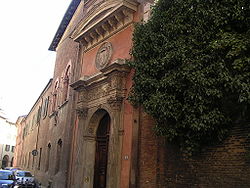
Collegio di Spagna
Encyclopedia




College
A college is an educational institution or a constituent part of an educational institution. Usage varies in English-speaking nations...
for Spanish
Spain
Spain , officially the Kingdom of Spain languages]] under the European Charter for Regional or Minority Languages. In each of these, Spain's official name is as follows:;;;;;;), is a country and member state of the European Union located in southwestern Europe on the Iberian Peninsula...
students at the University of Bologna
University of Bologna
The Alma Mater Studiorum - University of Bologna is the oldest continually operating university in the world, the word 'universitas' being first used by this institution at its foundation. The true date of its founding is uncertain, but believed by most accounts to have been 1088...
, Italy
Italy
Italy , officially the Italian Republic languages]] under the European Charter for Regional or Minority Languages. In each of these, Italy's official name is as follows:;;;;;;;;), is a unitary parliamentary republic in South-Central Europe. To the north it borders France, Switzerland, Austria and...
, which has been functioning since the 14th century. Its full original name in English translation was the College of Saint Clement of the Spaniards. It has been under the Royal patronage of the Spanish Crown since 1488, as authorized by Pope Innocent VIII.
History
The college was founded in 1364 by the Cardinal Gil Alvarez De AlbornozGil Alvarez De Albornoz
Gil Álvarez Carrillo de Albornoz was a Spanish cardinal and ecclesiastical leader.-Early years:Albornoz was born at Carrascosa del Campo, early in the 14th century. He was the son of Gil Állvarez de Albornoz and of Doña Teresa de Luna, sister of Jimeno de Luna, archbishop of Toledo and a member...
(1310–1367) and built in 1365–1367. The Collegio was the model for the colleges founded at the University of Salamanca
University of Salamanca
The University of Salamanca is a Spanish higher education institution, located in the town of Salamanca, west of Madrid. It was founded in 1134 and given the Royal charter of foundation by King Alfonso IX in 1218. It is the oldest founded university in Spain and the third oldest European...
, starting in the late 14th century (notably the Colegio Viejo, 1401) and at other Spanish universities in the following couple of centuries. Since 1488, all Spanish monarchs have reconfirmed its Royal patronage. It is arguably the oldest institution carrying the name Spanish outside of Spain, predating the union of the crowns that led to the formation of the Kingdom of Spain.
In 1923, a correspondent for The Times
The Times
The Times is a British daily national newspaper, first published in London in 1785 under the title The Daily Universal Register . The Times and its sister paper The Sunday Times are published by Times Newspapers Limited, a subsidiary since 1981 of News International...
, who calls the college a "picturesque Spanish oasis in the centre of old Bologna", reports of the visit of the King and Queen of Spain to the college. King Alfonso participated in the unveiling of a tablet recording the visit of the royal couple and another one noting the name of two famous former students of the College, Ignatius of Loyola
Ignatius of Loyola
Ignatius of Loyola was a Spanish knight from a Basque noble family, hermit, priest since 1537, and theologian, who founded the Society of Jesus and was its first Superior General. Ignatius emerged as a religious leader during the Counter-Reformation...
and Miguel Cervantes.
Art and architecture
It consists of a building in two floors with arcades surrounding a courtyard. The exterior has later been partly remodelled in renaissance style. The architecture of the Collegio is peculiarly Italian in the use of the loggiaLoggia
Loggia is the name given to an architectural feature, originally of Minoan design. They are often a gallery or corridor at ground level, sometimes higher, on the facade of a building and open to the air on one side, where it is supported by columns or pierced openings in the wall...
, but shares a characteristic of medieval college buildings in England and France, in being arranged around a central rectangular court. Bas reliefs of the coat of arms of Spain are located above the two main entryways.
The portico once had frescoes by Annibale Carracci
Annibale Carracci
Annibale Carracci was an Italian Baroque painter.-Early career:Annibale Carracci was born in Bologna, and in all likelihood first apprenticed within his family...
, but a travellers guide published in 1857 reported them having "almost disappeared". The guidebook goes on to describe two frescoes by Bartolommeo Bagnacavallo:
The book also mentions artwork in the chapel: "some frescoes by C. Procaccini and a Sta. Marguerite by G. Francia."
The frescoes by Camillo Procaccini
Camillo Procaccini
thumb|300px|Nativity by Camillo ProcacciniCamillo Procaccini was an Italian painter. He has been posthumously referred to as the Vasari of Lombardy, for his prolific Mannerist fresco decoration....
in the apse
Apse
In architecture, the apse is a semicircular recess covered with a hemispherical vault or semi-dome...
the S. Clemente chapel were painted in 1582 but destroyed in 1914. The S. Clemente also features an altarpiece by Marco Zoppo
Marco Zoppo
Marco Zoppo was an Italian painter of the Renaissance period, active mainly in his native Bologna. He was a pupil of the painter Lippo Dalmasio then for a few years with Francesco Squarcione around 1455, and thus part of the Bolognese School of painting. He was a contemporary of Andrea Mantegna...
from the mid-15th century.

